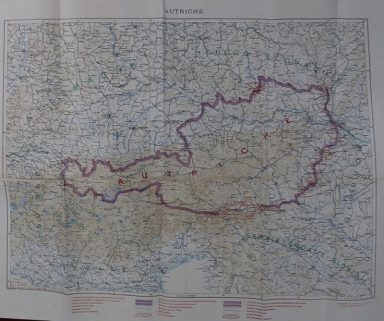via Boing Boing by Mark Frauenfelder
Charmingly simple, and simply charming, Co Hoedeman's stop-motion short, "Matrioska," (1970) gives life and humor to eight wooden nesting dolls. I couldn't help smiling at a few parts of the film.
[via The Kid Should See This]
==============================
via 3 Quarks Daily by Marie Gaglione

Things are changing. Always, everywhere, immensely and minutely, the history of mankind unfolds as we rotate around a grand burning star (also, everything everywhere else changes; the history of mankind may be of the least consequence on a cosmic scale, but I digress). I digress too early; I include parentheticals too soon; I stall with flowery descriptions of the sun. Because – ugh – I’m going to talk about “how divided we are as a nation.” It’s such a tired phrase; I don’t want to write about it. It’s stale because it’s static, and anyway, the declaration is often accompanied by divisive rhetoric. Wherever one may fall on the political spectrum (and here I’m being gracious; how often do we now identify with a “side”), they likely have established opinions of those who lie elsewhere. It does seem increasingly difficult to imagine a sweeping reconciliation when we continue to pour our definitions in concrete and defend our positions by reason of consistency. Inflexibility begets inability to listen, and thus to understand, which is why we find our differences so baffling and allow our prejudices to influence our opinions. So, finally, here it is: my own personal take on how we can get people to stop saying how divided we are. Bear with me, because I’m going to try and sell contradictions as potential energy for unity.
Continue reading
==============================
via Interesting Literature
In this week’s Dispatches from The Secret Library, Dr Oliver Tearle travels back 4,000 years to find the world’s first great epic.
In 1850, a series of clay tablets came to light in the Middle East, in what is now Iraq. They were shipped back to the British Museum, where they sat for some fifteen years before anyone got round to giving them any serious attention. Then, in 1865, a young man named George Smith was tasked with deciphering the cuneiform script inscribed on the tablets. Smith worked for a printing firm by day, but his real hobby was trying to work out what these ancient tablets said. For seven years he worked tirelessly on the clay tablets and, in 1872, he published his translation of what we now know as The Epic of Gilgamesh, a poem that had been lost from the literary canon for millennia but which has a claim to being the oldest surviving epic poem in the history of the world.
Continue reading
==============================
via Ancient Origins by Ashley Cowie

Skaill Norse Hall, the discovered Viking drinking hall below the present farmstead.
Source: UHI Archaeology Institute .
Archaeologists excavating on a tiny island off the north coast of Scotland have discovered an 800-year-old Viking ‘Bu’, or drinking hall , once serviced by a high-ranking Orcadian Norse chieftain.
The Discovery of the Viking Drinking Hall
Orkney was once a great seat of Viking power and the archipelago was ruled by the Scandinavian kingdom until 1468 AD when King Christian I of Denmark sold it to the Scottish crown. This newly discovered vestige of Orkney’s past Norse glory was discovered at Skaill Farmstead in Westness, on the island of Rousay and this ‘high-status’ Norse drinking hall is believed to date as far back as the 10th century.
Continue reading
==============================
via Boing Boing by David Pescovitz
From Toby's "Tibees" YouTube channel: "A math lesson about logarithms inspired by the legendary painter Bob Ross."
==============================
via Interesting Literature
Previously, we’ve gone among the rivers and streams with the poets, we’ve explored the forests and trees, and we’ve even taken to the seas with them. Now, it’s time to pick up your crampons and head to the mountains with these classic poems about hills and mountains from the Romantics to the present.
Continue reading
==============================
posted by S. Abbas Raza in 3 Quarks Daily: Richard Ford in Literary Hub:

Until I began the long and happy passage of reading all of Anton Chekhov’s short stories for the purpose of selecting the twenty for inclusion in The Essential Tales of Chekhov, I had read very little of Chekhov. It seems a terrible thing for a story writer to admit, and doubly worse for one whose own stories have been so thoroughly influenced by Chekhov through my relations with other writers who had been influenced by him directly: Sherwood Anderson. Isaac Babel. Hemingway. Cheever. Welty. Carver.
As is true of many American readers who encountered Chekhov first in college, my experience with his stories was both abrupt and brief, and came too early. When I read him at age twenty, I had no idea of his prestige and importance or why I should be reading him—one of those gaps of ignorance for which a liberal education tries to be a bridge. But typical of my attentiveness then, I remember no one telling me anything more than that Chekhov was great, and that he was Russian.
Continue reading
==============================
via Ancient Origins by Sarah P Young

Mask of pharaoh Tutankhamun. Source: Dieter Hawlan / Adobe Stock.
The incredible golden mask with its dark blue stripes of lapis lazuli and serious young face is probably the most famous ancient artifact in the world. It is instantly recognizable, and the iconic death mask has ensured millions of people remember the name of the man whose mummy it adorned – Tutankhamun.
He was a pharaoh of Egypt who ruled between approximately 1332 BC and 1323 BC ascending the throne at only nine years of age. But his youth and relatively short time as pharaoh belie the significance of his reign.
Continue reading
==============================
via The National Archives Blog by James Cronan

Boundaries of Austria by the Treaty of St. Germain-en-Laye, 10 September 1919, showing old boundaries and plebiscite area. Catalogue reference: FO 925/20026
The Treaty of Versailles, signed with Germany on 28 June 1919, brought an official end to the war between Germany and the Allied and Associated Powers, but it did not bring an end to the peace negotiations. There were still treaties to be signed with Germany’s partners who had formed the Central Powers in the First World War: Austria, Hungary, Turkey and Bulgaria. The first of these was to be Austria.
Continue reading
==============================
via Interesting Literature
In this week’s Dispatches from The Secret Library, Dr Oliver Tearle reads an enjoyable and high-octane fantasy from one of the genre’s most original voices
Here’s a question for you. Have you heard of the poet William Ashbless? He has his own Wikipedia page. Yet he doesn’t exist. He never has. Ashbless was the creation of two writers, Tim Powers and James Blaylock, in the 1970s when they were college students. Unimpressed by the terrible poetry being published in their school magazine, Blaylock and Powers decided to invent their own poet and submit ‘his’ work to the magazine as a joke. It was enthusiastically accepted.
Continue reading
No comments:
Post a Comment